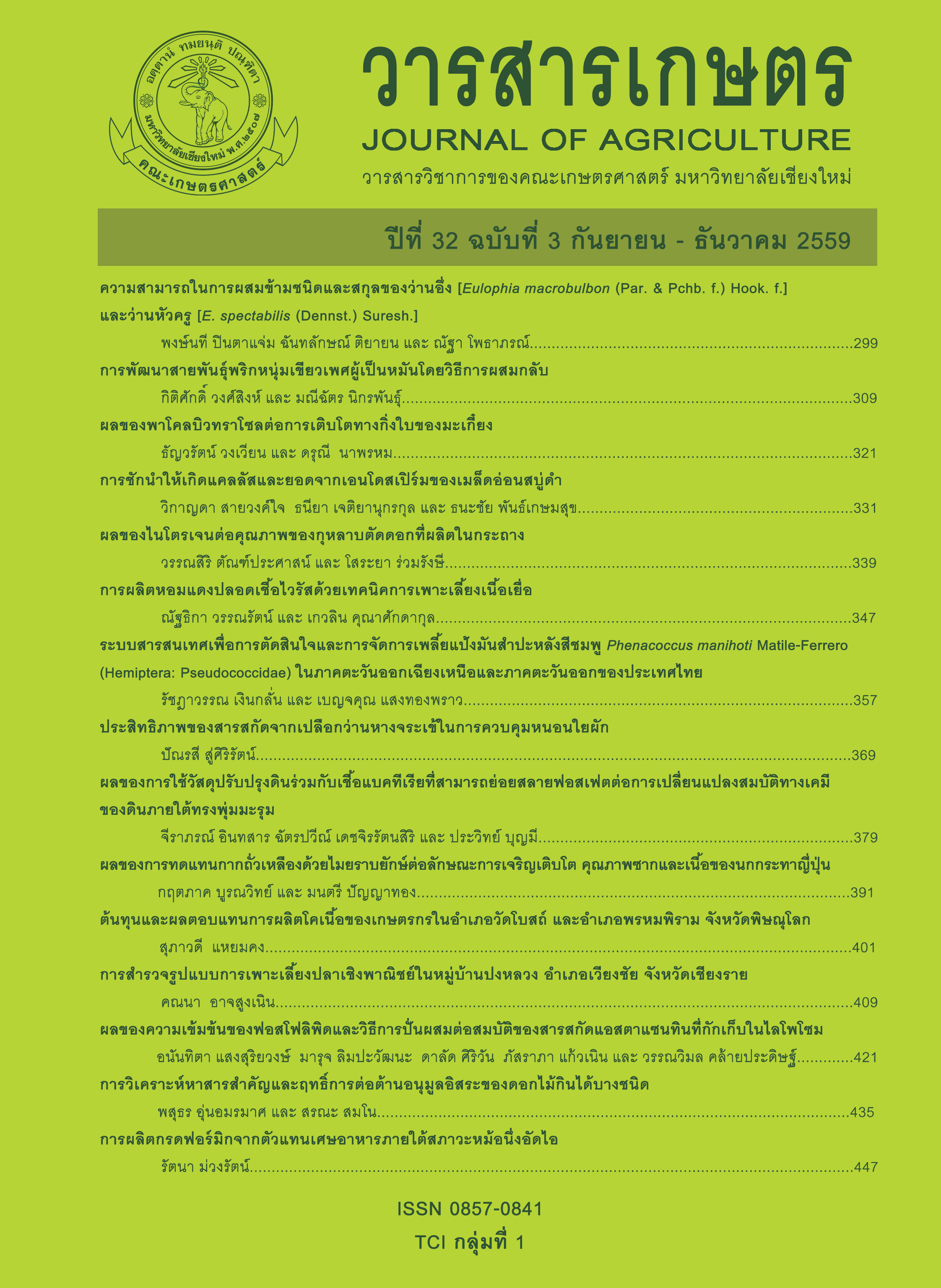ระบบสารสนเทศเพื่อการตัดสินใจและการจัดการเพลี้ยแป้งมันสำปะหลังสีชมพู <I>Phenacoccus manihoti</I> Matile-Ferrero (Hemiptera: Pseudococcidae) ในภาคตะวันออกเฉียงเหนือและภาคตะวันออกของประเทศไทย
Main Article Content
บทคัดย่อ
ระบบสารสนเทศภูมิศาสตร์ เทคโนโลยีการสำรวจระยะไกล และการสร้างแบบจำลองถิ่นอาศัยด้วยซอฟต์แวร์ Maxent ได้ถูกนำมาใช้ในการสร้างแผนที่ทำนายความเสี่ยงสำหรับเพลี้ยแป้งมันสำปะหลังสีชมพู Phenacoccus manihoti Matile-Ferrero ในภาคตะวันออกเฉียงเหนือและภาคตะวันออกของประเทศไทย โดยทำการสำรวจประชากรเพลี้ยแป้งมันสำปะหลังสีชมพูในพื้นที่เพาะปลูกมันสำปะหลังจำนวน 255 แปลง ครอบคลุมจังหวัดปราจีนบุรี ระยอง สระแก้ว และนครราชสีมา ระหว่างเดือนมิถุนายน 2556 ถึง มกราคม 2557 ได้ข้อมูลตำแหน่งพิกัดภูมิศาสตร์ของแปลงที่ปรากฏเพลี้ยแป้งมันสำปะหลังสีชมพูจำนวน 204 แปลง และข้อมูลด้านสิ่งแวดล้อมจากภาพถ่ายดาวเทียม MODIS และ สถานีตรวจอากาศอัตโนมัติ 12 สถานี มาทำการสร้างแบบจำลองการกระจายตัวของประชากร พบว่าพื้นที่ที่มีปริมาณน้ำฝนรายเดือนระดับต่ำที่ 100-135 มม. ค่าอุณหภูมิผิวดินระหว่างวัน (LSTD) ที่ -100 ถึง -30 ºC และค่าดัชนีพืชพรรณ (NDVI) ระหว่าง -0.3 และ 0.6 เป็นสภาวะแวดล้อมที่เหมาะสมกับเพลี้ยแป้งมันสำปะหลังสีชมพู ค่า AUC ที่ 0.981 แสดงว่าแบบจำลองมีความน่าเชื่อถือในระดับดีเยี่ยม พื้นที่เสี่ยงที่ระดับอำเภอในจังหวัดนครราชสีมา ปราจีนบุรี สระแก้ว ฉะเชิงเทรา ชลบุรี และระยองได้ถูกอธิบายไว้ในการศึกษาครั้งนี้
Article Details
References
ขนิษฐา สุทธิบริบาล สมนิมิตร พุกงาม และ ปิยพงษ์ ทองดีนอก. 2554. การประเมินค่าความชื้นในดินโดยใช้ดัชนีพืชพรรณบริเวณไร่มันสำปะหลัง อำเภอครบุรี จังหวัดนครราชสีมา. วารสาร วนศาสตร์ 30 (3): 24-32.
ชลิดา อุณหวุฒิ. 2554. อนุกรมวิธานของเพลี้ยแป้งในมันสำปะหลัง. หน้า 35-39. ใน: รายงานผลงานวิจัยประจําปี 2554 สํานักวิจัยพัฒนาการอารักขาพืช. กรมวิชาการเกษตร.
เผ่าไท ถายะพิงค์ และ ปิยะวรรณ สุทธิประพันธ์. 2558. การประยุกต์ใช้เทคโนโลยีภูมิสารสนเทศในการศึกษาความหลากชนิดและการแพร่กระจายของแมลงศัตรูกาแฟอราบิกาในจังหวัดหวัดเชียงใหม่และเชียงราย. วารสารเกษตร 31(2): 203-213.
วลัยพร ศะศิประภา นรีลักษณ์ วรรณสาย สุภาพร ราจันทึก และ ณิชา โป๋ทอง. 2555. ความสัมพันธ์ระหว่างดัชนีพืชพรรณผลต่างแบบนอร์แมลไลซ์กับผลผลิตมันสำปะหลังในจังหวัดกำแพงเพชร. วารสารวิชาการเกษตร 30(3): 290-299.
สถาบันพัฒนามันสำปะหลัง. 2553. คู่มือการเลี้ยงและการขยายพันธุ์แตนเบียน Anagyrus lopezi เพื่อควบคุมเพลี้ยแป้งมันสำปะหลัง. เอกสารวิชาการ. มูลนิธิสถาบันพัฒนามันสำปะหลังแห่งประเทศไทย สถาบันพัฒนามันสำปะหลัง (ห้วยบง), นครราชสีมา. 16 หน้า.
สถาบันสารสนเทศทรัพยากรน้ำและการเกษตร (องค์การมหาชน). 2558. บันทึกเหตุการณ์ภัยแล้ง 2557/2558. (ระบบออนไลน์). แหล่งข้อมูล: http://www.thaiwater.net/current/drought58/drought58.html (24 พฤศจิกายน 2555).
อัมพร วิโนทัย ประภัสสร เชยคำแหง รจนา ไวยเจริญ ชลิดา อุณหวุฒิ อิสระ พุทธสิมมา วัชริน แหลมคม และ เถลิงศักดิ์ วีระวุฒิ. 2553. การนำเข้าแตนเบียน Anagyrus lopezi เพื่อควบคุมเพลี้ยแป้งมันสำปะหลังสีชมพู. (ระบบออนไลน์). แหล่งข้อมูล: http://www.doa.go.th/ research/files/1796_2553.pdf. (24 พฤศจิกายน 2555).
โอภาษ บุญเส็ง. 2552. เพลี้ยแป้ง มหันตภัยต่อมันสำปะหลัง. (ระบบออนไลน์). แหล่งข้อมูล:http://thaitapiocastarch.org/article20_th.asp (24 พฤศจิกายน 2555).
Bellotti, A.C., A.R. Braun, B. Arias, J.A. Castillo and J.M. Guerrero. 1994. Origin and management of neotropical cassava arthropod pests. African Crop Science Society 2: 407-417.
Bellotti, A.C., L. Smith and S.L. Lapointe. 1999. Recent advances in cassava pest management. Annual Review of Entomology 44: 343-370.
Iheagwam, E.U. and M.C. Eluwa. 1983. The effects of temperature on the development of the immature stages of the Cassava Mealybug, Phenacoccus manihoti Mat-Ferr. (Homoptera, Pseudococcidae). Deutsche Entomologische Zeitschrift 30(1-3): 17-22.
Lema, K.M. and H.R. Herren. 1985. The influence of constant temperature on population growth rates of the cassava mealybug, Phenacoccus manihoti. Entomologia Experimentalis et Applicata 38(2): 165-169.
Le Rü, B.P. and Y. Iziquel. 1990. An experimental study, with the aid of a rain simulator, of the mechanical effect of rainfall on populations of the cassava mealybug, Phenacoccus manihoti. Acta Oecologica 11(5): 741-754.
Nassar, N. M.A. and R. Ortiz. 2007. Cassava improvement: challenges and impacts. The Journal of Agricultural Science 145: 163-171.
Parsa, S., T. Kondo and A. Winotai. 2012. The cassava mealybug (Phenacoccus manihoti) in Asia: first records, potential distribution, and an Identification Key. PLoS ONE. 7(10): e47675.
Peterson, A.T. 2006. Uses and requirements of ecological niche models and related distributional models. Biodiversity Informatics 3: 59-72.
Peterson, A.T. and D.A. Vieglais. 2001. Predicting species invasions using ecological niche modeling: new approaches from bioinformatics attack a pressing problem. BioScience 51(5): 363-371.
Poramacom, N., A. Ungsuratana, P. Ungsuratana and P. Supavititpattana. 2013. Cassava production, prices and related policy in Thailand. American International Journal of Contemporary Research 3(5): 43-51.
Ratanawaraha, C., N. Senanarong and P. Suriyapan. 2000. Status of cassava in Thailand: Implications for future research and development. Proceedings of the validation forum on the global cassava development strategy. Rome, April 26-28, Vol. 3. FAO/International Fund for Agricultural Development.
Soysouvanh, P. and N. Siri. 2013. Population abundance of pink mealybug, Phenacoccus manihoti on four cassava varieties. Khon Kaen Agriculture journal J. 41(SUPPL. 1): 149-153.
Warren, D. and S. Seifert. 2011. Environmental niche modeling in Maxent: the importance of model complexity and the performance of model selection criteria. Ecological Applications 21: 335-342.

